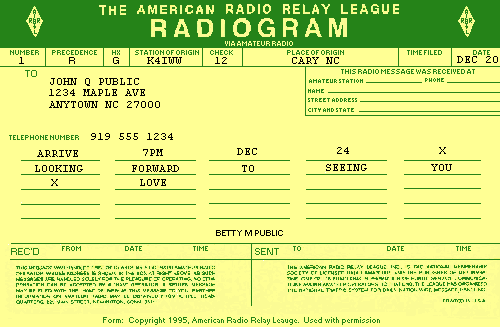

GENERAL
Follows a description of the different parts of the Amateur Radio
Message format. Some sections are OPTIONAL, and I recommend they not
be used, unless needed. The use of this pre-printed message form from
ARRL is NOT necessary for handling traffic. Use any paper you seem
appropriate.
This can be any number the originating stations chooses. Most start with 1 the first of each year. Once a message is numbered, that same number remains with the message until delivered. Example: NR 1
The Precedence of the Message determines what order the messages will be handled. Most of the time all messages are handled on every net session. The following four precedences are used in ascending order of priority:
Example: NR 1 R (for Routine)
HANDLING INSTRUCTIONS (Optional)
Handling Instructions are sometimes used to tell the various stations along the way, what the desires of the originating station are. If not needed, it is best not to use. On phone: the sending station would say, "HANDLING INSTRUCTIONS n", n explained below. On CW: Send HXn.
Example: NR 1 R HXG
Example: NR 1 R K4IWW
Example: NR 1 R K4IWW 12
Example: NR 1 R K4IWW 12 CARY NC
The time the message was originated. You may either use UTC or Local time. Examples: 1615Z or 1115 EST. Most messages do NOT use this field. It is only useful if the message has a short time value.
Example: NR 1 R K4IWW 12 CARY NC 1615Z
This is the date the message was originated. In Amateur Radio, we use month and day. The year is NOT used. If the message is over a year old, it should be sent to the circular file.
Example: NR 1 R K4IWW 12 CARY NC 1615Z DEC 20
The name(s) and address of the person to which this message is going. It looks like the address on an envelope used in snail mail. Include a phone number, if you have it. The more information here, the easier the delivery will be.
Example:
JOHN Q PUBLIC
1234 MAPLE AVE
ANYTOWN NC 27000
919 555 1234
DELIVERING STATION INFO (Optional)
This section is rarely used. If the message is to be mailed or hand delivered, it is nice to put your (the delivering station) info here so the addressee can reach you if there is any question, or they want to send a return message. Most messages are delivered by phone.
Finally! This is the message you are sending for the signature person to the addressee. It should be short (usually less than 25 words) and in telegram style. No punctuation is used. The letter "X" is used (similar to STOP in telegrams) to end one idea and start another. Many messages do not even have an "X" in them. Example TEXT:
ARRIVE 7PM DEC 24 X
LOOKING FORWARD TO SEEING YOU
X LOVE
The above TEXT has a count of 12. So the CHECK is 12. As Amateur Radio is non-commercial, the TEXT should have no commercial value. Each Radio Amateur is the judge of what is commercial and what is not.
This is the name if the person sending the message. It may be the name or call of the originating station. However, it is usually the name of a "third party", for whom the originating station is generating the message.
This is for the handling station to write down whom they received the message from. This field is only for the book keeping of the handling station.
SENT (Optional)
This is for the handling station to write down whom they sent the
message to. This field is only for the book keeping of the handling
station.